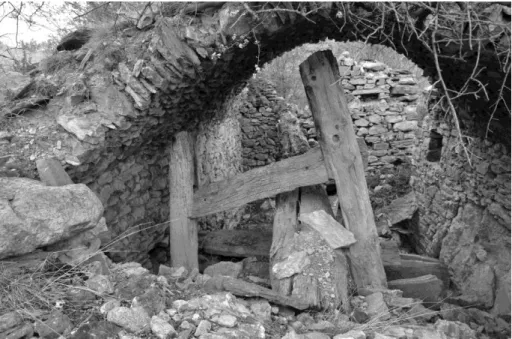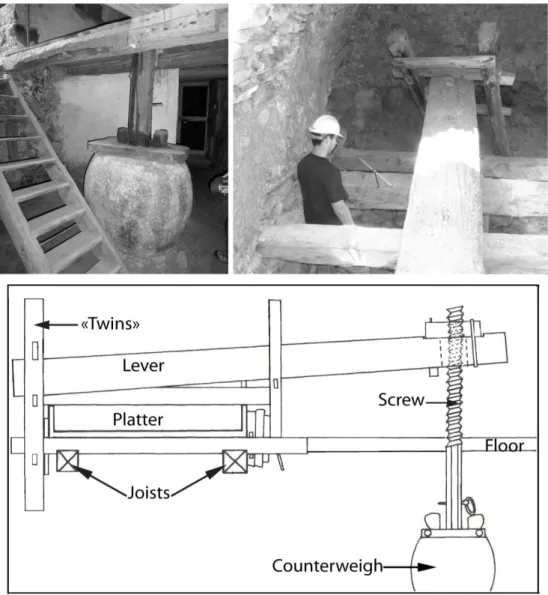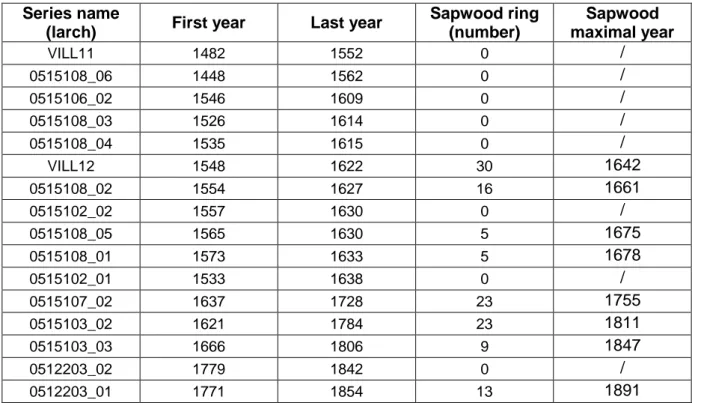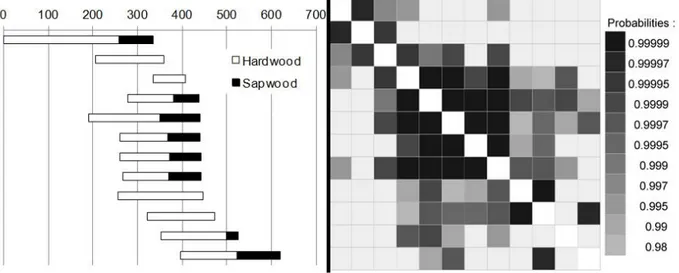HAL Id: hal-01344922
https://hal.archives-ouvertes.fr/hal-01344922
Submitted on 12 Jul 2016HAL is a multi-disciplinary open access archive for the deposit and dissemination of sci-entific research documents, whether they are pub-lished or not. The documents may come from teaching and research institutions in France or abroad, or from public or private research centers.
L’archive ouverte pluridisciplinaire HAL, est destinée au dépôt et à la diffusion de documents scientifiques de niveau recherche, publiés ou non, émanant des établissements d’enseignement et de recherche français ou étrangers, des laboratoires publics ou privés.
Distributed under a Creative Commons Attribution - NonCommercial - NoDerivatives| 4.0 International License
Dendrochronoecology of ancient wine presses in the
Southern French Alps
Lisa Shindo, Jean-Louis Edouard, Frédéric Guibal
To cite this version:
Lisa Shindo, Jean-Louis Edouard, Frédéric Guibal. Dendrochronoecology of ancient wine presses in the Southern French Alps. Hevia A., Sánchez-Salguero R., Linares J. C., Olano J. M., Camarero J. J., Gutiérrez E., Helle G., Gärtner H. TRACE - Tree Rings in Archaeology, Climatology and Ecology, V. 14, 14, pp.120-127, 2016. �hal-01344922�
1 (post print version)
Dendrochronoecology of ancient wine presses in the Southern
French Alps
L. Shindo1, 2, J.-L. Edouard1 and F. Guibal²
1
Aix Marseille Université, CNRS, Ministère de la Culture et de la Communication, CCJ UMR 7299, 13094 Aix en Provence, France
2
Aix Marseille Université, CNRS, IRD, Avignon Université, IMBE UMR 7263, 13397, Marseille, France shindo@mmsh.univ-aix.fr
Introduction
In the Southern French Alps wine growing was a common practice to an altitude of 1300 m until recent times (Blanchard 1930). This past activity is evidenced by several impressive wine presses located at high elevation. Given this issue is poorly documented by archives, ten ancient wine presses were studied by using dendrochronology in order to find out more about this original heritage. How old are these structures? Which timber species were used and were they built in several stages?
2 (post print version) Presentation
Studied area
The studied area is the upper Durance Valley, near Briançon, at an altitude of some 1100 m (Fig. 1) (WGS84 coordinates of la Vignette site are: latitude: 44.813331 and longitude: 6.569162). Normally, vineyards are not present at that altitude, but, thanks to the exceptional sun radiation (due to the influence of the Mediterranean climate) on the large southern limestone slopes, the vine is potentially plentiful (Blanchard 1930).
Latest development
In this area, viticulture is mentioned in archives from the 12th century (Pogneau 2001) and the activity went on until the 19th century. Several factors caused the end of the Southern alpine viticulture, Phylloxera epidemic around 1890, competition with Provence wine brought with the railway and decline of agriculture activity which started ca. 1870 (Mouthon 2011). Nowadays, there is no more wine production and the wine presses are abandoned. A few of them are still in good condition, while others are being neglected, exposed to climatic stresses (snow, wind, drought) and thieves (Fig. 2).
Figure 2: An abandoned wine presse at la Vignette site (V. Labbas).
The wine presses
There are two kinds of wine press cellars: those in villages, on the lower floor of the farms, and those close to (or inside) the vineyards. However, the internal elements of the wine presses are all of the same design. They are huge devices, completely made in wood and are called “lever presses”. How were they working? The grapes were dropped off into a platter and, thanks to a stone counterweigh, a lever crushed the fruits. Then the grape juice was recovered under the press (Mallé 1991). The lever, nearly as large as a tree trunk, is retained between the “twins”, that is two posts placed on the counterweight opposite side. So, these wine presses were all built on two different levels: the counterweight on the first level, and, the lever and the platter on the second level (Fig. 3).
3 (post print version)
Figure 3: Two pictures of studied wine presses and a cross-section of the device (Shindo based on Mallé 1999 p.113).
The wine presses are located between the altitude of 970 m to 1200 m, in La Roche-de-Rame and St-Martin-de-Queyrières villages. Three of them are located in cellars of inhabited farms. The other seven are located in la Vignette site (Segard 2000) where nearly 14 hectares of vineyards were cultivated (Mallé 1999, Pogneaux 2001). In 1869, eighty cellars with wine press were mentioned, on la Vignette land register (Association La Vignetto 2011) but in 2013-214 we only found seven of them in a good condition.
Material and methods
We sampled forty-one beams with a Pressler increment borer (Haglöf, Sweden) and sometimes with an electric Rinntech driller. Function and wood species of the beams are depicted in Table 1. In the lab, ring-widths were measured using the incremental measuring table LINTAB with 0.01 mm accuracy and TSAP-Win software (Rinntech Company, Heidelberg, Deutschland). Then, tree-ring series were crossdated by mean of DENDRON IV software DENDRON-IV (developed with RunRev LiveCode, Edinburgh, Scotland by G.-N. Lambert CNRS, University of Franche-Comté, Besançon, France and University of Liege, Belgium. Version: 2015 02 21).
4 (post print version) Results and discussion
Wood anatomy and timber function
Wood identification shows that larch (Larix decidua Mill.) is the main species (61,0%) in the wine presses. Besides that, Scots pine type (Pinus sylvestris L.)1 was also used (34.1%). Initially, we thought that these wine presses were only made with larch because in mountain and subalpine vegetation stages, larch is an abundant species, commonly used in local architecture. However, Scots pine is available too in the mountain zone of this region, and even if it is less used for building, it proved to be used quite often.
Joists are mainly made in larch and levers are mainly in Scots pine. So far, sample size is too small to draw general conclusions. Nearly twenty other timbers could be sampled in la Vignette site, but because of the poor state of conservation of the structures, it is dangerous to approach them.
Scots pines used in the wine presses are larger and older than larches. Wood studies evidence that mechanical properties of larch and Scots pines are quite similar (Barnet et al. 2003). So, if the levers are mainly made in Scots pine, that would mean that large trees of this species used to be more available than larch in the surrounding forests.
Table 1: Species and function of the sampled wood pieces.
Function Larch Scots pine Fir total
“twin” 2 4 0 6 lever 2 7 0 9 platter 0 2 0 2 joist 12 2 1 15 Various timber 8 0 0 8 total 25 15 1 41 Larch dating
Sixteen of the larches beams cross-match with the southern French Alps larch master chronologies (Edouard 2010a and b, Corona et al. 2011a and 2011b). Statistical agreement between the larch series and the master chronologies are indicated in Table 2.
Table 2: Results of the larch mean chronology synchronisation with the master chronologies. Only the best five results are presented here.
Date of the first ring Date of the last ring Covering (shared years) Probability /
security Student t. Rank
Master chronology 1448 1806 353 0.999995 9,5 1 Oriol 1448 1806 272 0.999995 9,05 1 MoulRef1c 1448 1806 251 0.999995 8,56 1 GrangesRef1 1448 1806 300 0.999995 8,4 1 LachRef1 1448 1806 196 0.999995 8,34 1 HipRef1
1 Pinus sylvestris L. and Pinus uncinata Ramond cannot be distinguished on the basis of their
5 (post print version)
Table 3: Larches dating details and sapwood maximal estimated year (confidence level 95%).
Series name
(larch) First year Last year
Sapwood ring (number) Sapwood maximal year VILL11 1482 1552 0 / 0515108_06 1448 1562 0 / 0515106_02 1546 1609 0 / 0515108_03 1526 1614 0 / 0515108_04 1535 1615 0 / VILL12 1548 1622 30 1642 0515108_02 1554 1627 16 1661 0515102_02 1557 1630 0 / 0515108_05 1565 1630 5 1675 0515108_01 1573 1633 5 1678 0515102_01 1533 1638 0 / 0515107_02 1637 1728 23 1755 0515103_02 1621 1784 23 1811 0515103_03 1666 1806 9 1847 0512203_02 1779 1842 0 / 0512203_01 1771 1854 13 1891
Figure 4 shows the bar diagram of the dated beams. Bark is never preserved so sapwood and/or heartwood rings may have been lost. Accordingly the exact felling date of any of these trees cannot be assessed.
Nevertheless, some of the samples have retained sapwood rings: therefore a method taking in count sapwood theoretical maximal number of ring can be applied (Baillie 1982). Therefore, a date of tree felling can be assessed.
Indeed, the study of 267 living larch from the same geographical area showed that larches they have between 14 and 50 (32 ± 18) sapwood rings (confidence level 95%) (Shindo unpublished). That made it possible to estimate the theoretical felling time interval for eight of the dated larches that still have sapwood (Tab. 3 and Fig. 4).
As regards samples without any sapwood rings, heartwood may have been eroded too so it is only possible to put forward a terminus post quem, wich is a date beyond which the tree could have been felled down. That is the date of the last measured ring plus the minimal number of sapwood rings i.e.14.
Accordingly, dendrochronology highlights these structures were built between the 17th and the 19th centuries. There is a major construction stage in the mid 17th century (1634-1642) and then, other construction stages in the mid 18th century (one wood piece felled between 1729 and 1755), in the first half of the 19th century (1807-1811) and in the second half of the 19th century (1855-1891). Timbers are not reused (no former assembly marks) so their dates correspond with their setting in the wine presses.
Dendrochronology provides detailed information on south alpine wine presses. It proves that the southern French alpine viticulture dates back at least to the 17th century, during the Little Ice Age (Grove 2003, Corona et al. 2011b). Therefore, at this time, local climatic conditions were convenient for grape maturation, in spite of the prolonged cold spell: making wine was culturally of the utmost importance, like in other areas (Pfister 1988, Le Roy Ladurie 1967, 1983).
6 (post print version) 1400 1500 1600 1700 1800 1900 VILL11 0515108_06 0515106_02 0515108_03 0515108_04 VILL12 0515108_02 0515102_02 0515108_05 0515108_01 0515102_01 0515107_02 0515103_02 0515103_03 0512203_02 0512203_01 Heartwood Sapwood
Tree estimated f elling phase
Minimal estimated number of sapwood rings
Figure 4: Estimated felling phase of eight of the dated larches (confidence level 95%).
Scots pine study
A mean chronology including twelve of the fifteen Scots pines series has been developed (fig. 5). It spans a 620-year period (ring-width series have between 71 and 334 years).
Figure 5: Left: bar diagram of the twelve cross-matched Scots pine series.
Right: Square matrix of probabilities associated with the Student t value for the twelve correlated Scots pine series (standardised by the Corridor method (Lambert 2006)). The darker is the box, the higher is the crossdating probability between the series (matrix automatically drawn by Dendron IV software Lambert 2014).
7 (post print version)
Until now, Scots pines series could not be dated, whether it concerns the mean chronology (twelve series) or the fifteen individual series. These results suggest that either these series may be older than the local reference chronology utilised, 1728-1999 (Edouard, unpublished), or that Scots pine trees used for wine presses may have grown in very particular site conditions, triggering ring-width patterns different from those of the reference chronology . In addition to that, attempts were carried out using other tree species (larch, Arolla pine) as references: no valuable crosscorrelation was obtained.
Conclusions
A preliminary dendrochronological study of ten wine presses in the Southern French Alps evidence the multiple tree species utilized. These structures are not only made with larch: Scots pine and fir were also used.
Apparently there is no species distinction for the wine presses pieces, except maybe for joists which are mainly made in larch and lever, mainly in Scots pine. Scots pines pieces are larger and older than larch pieces. The dating of the Scots pines series will shed light both on this original heritage and on the local past pine forests.
It is now demonstrated that vine was cultivated and wine presses built, at least from the 17th c. until the end of the 19th century. It tends to fall into the demographic optimum and the Little Ice Age period, a supposed unfavorable period for viticulture in mountain areas. Then, Phylloxera epidemic, competition with Provencal wine and decline of agricultural activity, all contributed to the demise of viticulture. Later, the felling phases should be refined, maybe with the twenty others timbers not yet sampled).
Last, archaeological studies are now required to provide a context on these structures and look for any relationship with earlier periods.
Acknowledgements
The authors thank La Vignetto association members for their help, G.-N. Lambert for his suggestions and L. Bernard, F. Mocci and E. Shindo for the review of this paper.
References
Association La Vignetto (2011): L’histoire d’un passé enfoui. Unpublished. 19. Baillie M.G.L. (1982): Tree-ring dating and archaeology. Croom-Helm, London. 274.
Barnett J.R., Jeronimidis G. (2003): Wood quality and its biological basis. Blackwell Publishing Ltd. 226.
Blanchard R. (1930): La répartition de la vigne dans les Alpes françaises. Revue de
géographie alpine, 18-2: 221-261.
Corona C., Edouard J.-L., Guibal F., Lambert G., Py V., Guiot J., Thomas A. (2011a): Last-millenium summer-temperature variations in Briançonnais, French Alps, based on a composite larch tree-ring chronology. In Fraiture P. (ed.): Tree Rings, Art, Archaeology, Proceedings of the conference, Brussels, Royal Institute for Cultural Heritage, 10-12 February 2010. Scientia Artis 7. 49-65.
8 (post print version)
Corona C., Edouard J.-L., Guibal F., Guiot J., Bernard S., Thomas A., Denelle N. (2011b): Long-term summer (AD751-2008) temperature fluctuation in the French Alps based on tree-ring data. Boreas 40: 351-366.
Edouard J.-L. (2010a): Longue chronologie de cernes du mélèze et occupation humaine depuis plus de mille ans dans la vallée de la Clarée (Briançonnais, Alpes françaises). Tzortzis S., Delestre X. (ed.) : Archéologie de la montagne européenne, Actes de la table ronde internationale de Gap, 29 septembre- 1er Octobre 2008, Bibliothèque d’archéologie méditerranéenne et africaine, n°4, Errance, 325-333.
Grove J.M. (2003): The Little Ice Age. Taylor & Francis. 520.
Lambert G.-N. (2006): Dendrochronologie, histoire et archéologie, modélisation du temps. Le logiciel Dendron II et le projet Historik Oaks, V1 et V2, Habilitation à diriger les recherches, Besançon. Unpublished.152 & 206.
Le Roy Ladurie E. (2004): Histoire humaine et comparée du climat. Canicules et glaciers (XIIIe-XVIIIe siècle). Fayard. 739.
Mallé M.-P. (1999): L’habitat du nord des Hautes-Alpes. Patrimoine architectural et mobilier. Association pour le patrimoine de Provence et Société d’étude des Hautes-Alpes. 440. Mouthon F. (2011): Histoire des anciennes populations de montagne. Des origines à la modernité. Essai d’histoire comparée. L’Harmattan. 373.
Pfister C., Guerreau A. (1988): Une rétrospective météorologique de l’Europe. Un système de reconstitution de l’évolution du temps et du climat en Europe depuis le Moyen Age central. Histoire & Mesure, 3-3: 313-358.
Pogneaux N. (2001): Le vignoble d’altitude. Bacchus y trouva un royaume ! Edition du Fournel, L’Argentière-La Bessée. 96.
Segard M. (2000): Rapport d’opération archéologique sur le site de La Vignette, document final de synthèse, DRAC PACA SRA, Aix-en-Provence. Unpublished. 14.
Shindo L. (2016):





